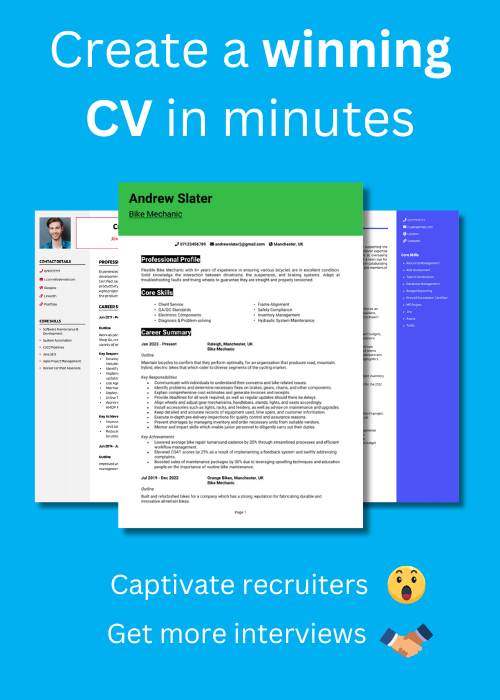As a good marketer, you can sell anything – products, services, even ideas. But before you can prove your ability to craft compelling campaigns, build brand awareness, or drive conversions, you need to sell something even more important: yourself.
This guide will walk you through how to write a marketing CV that highlights your expertise, with 5 Marketing CV examples that’ll help showcase your achievements and ensure your application is as persuasive as your best campaign.
Digital Marketer CV example
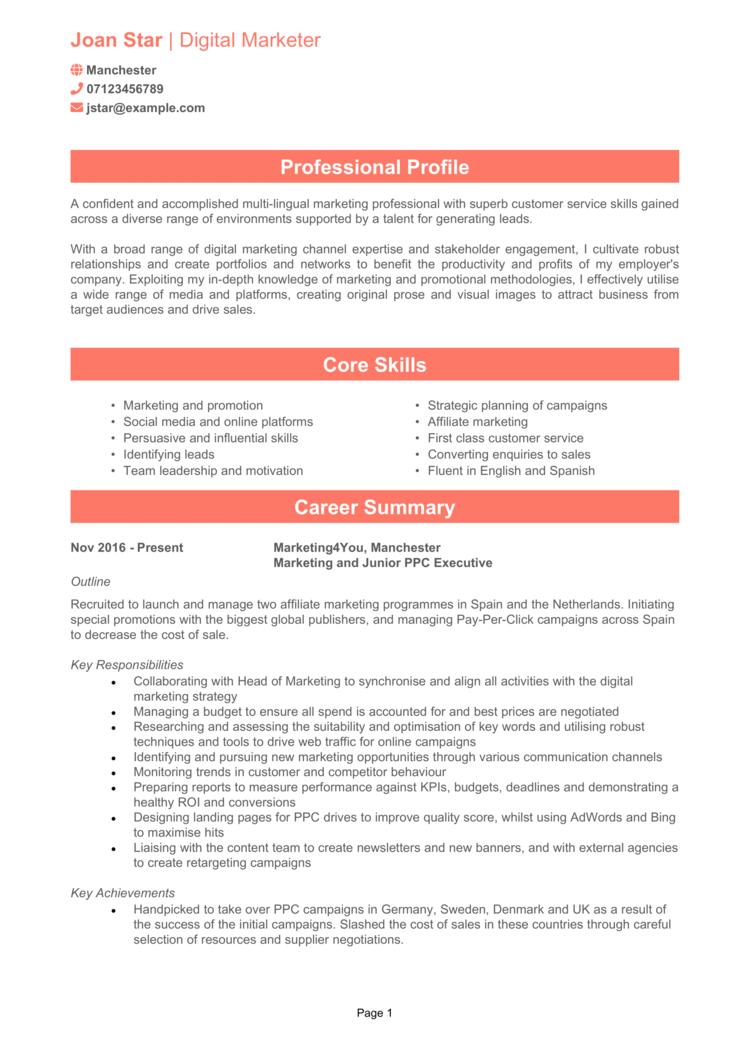
Head of Marketing CV example
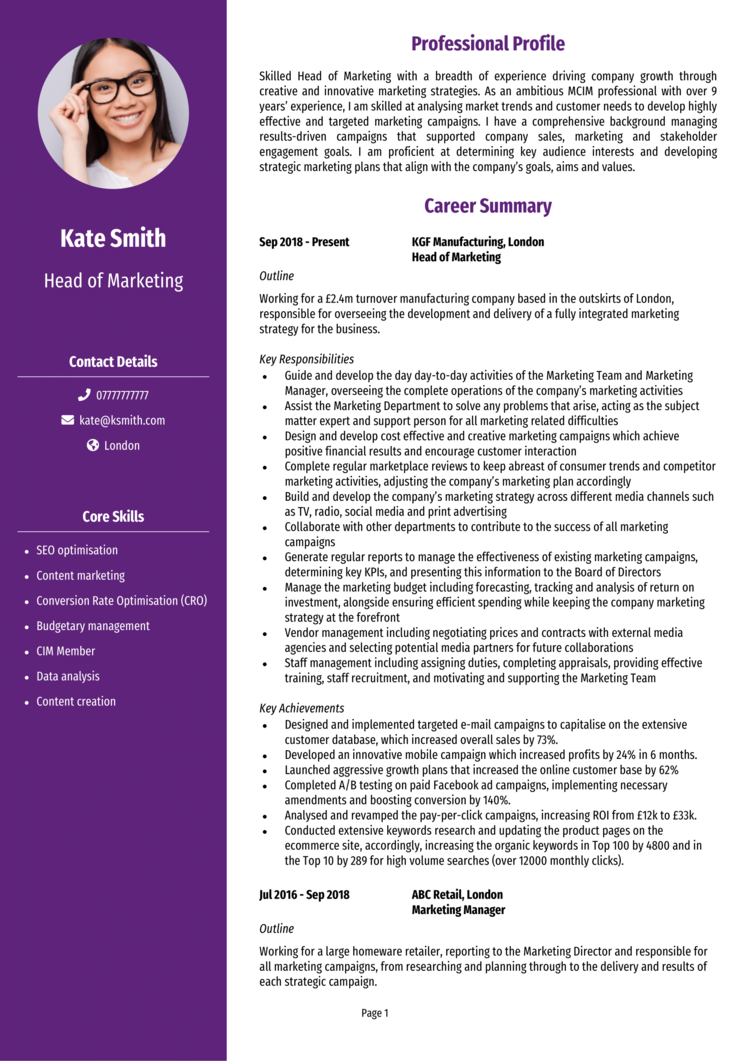
Marketing Officer CV example
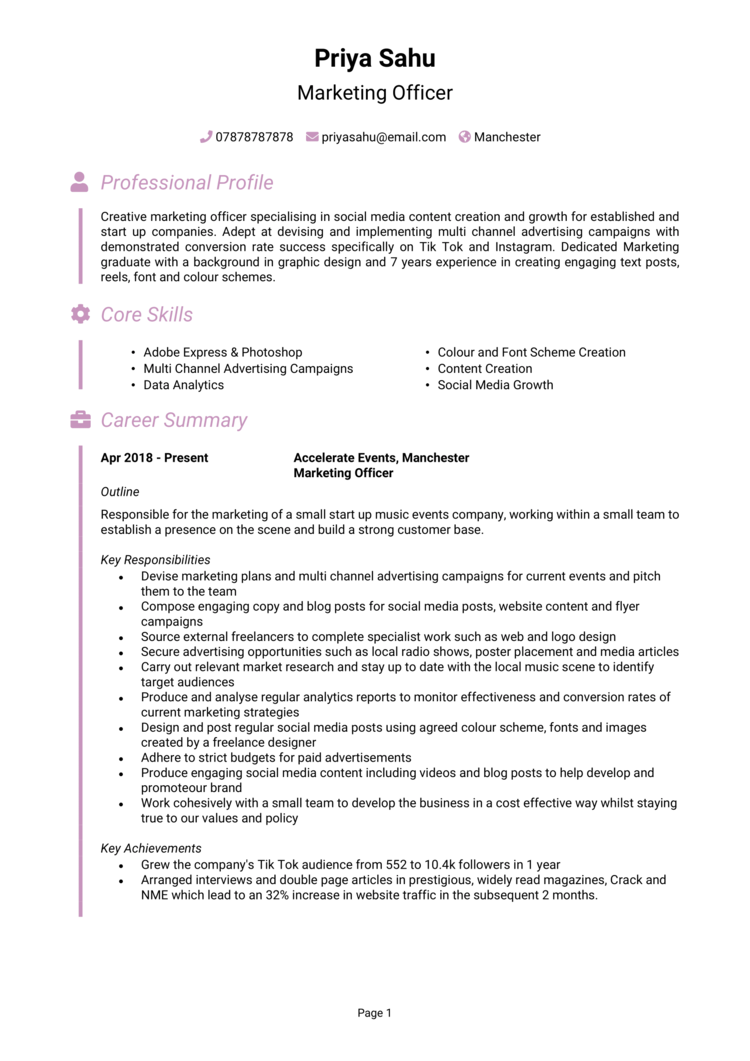
Chief Marketing Officer CV
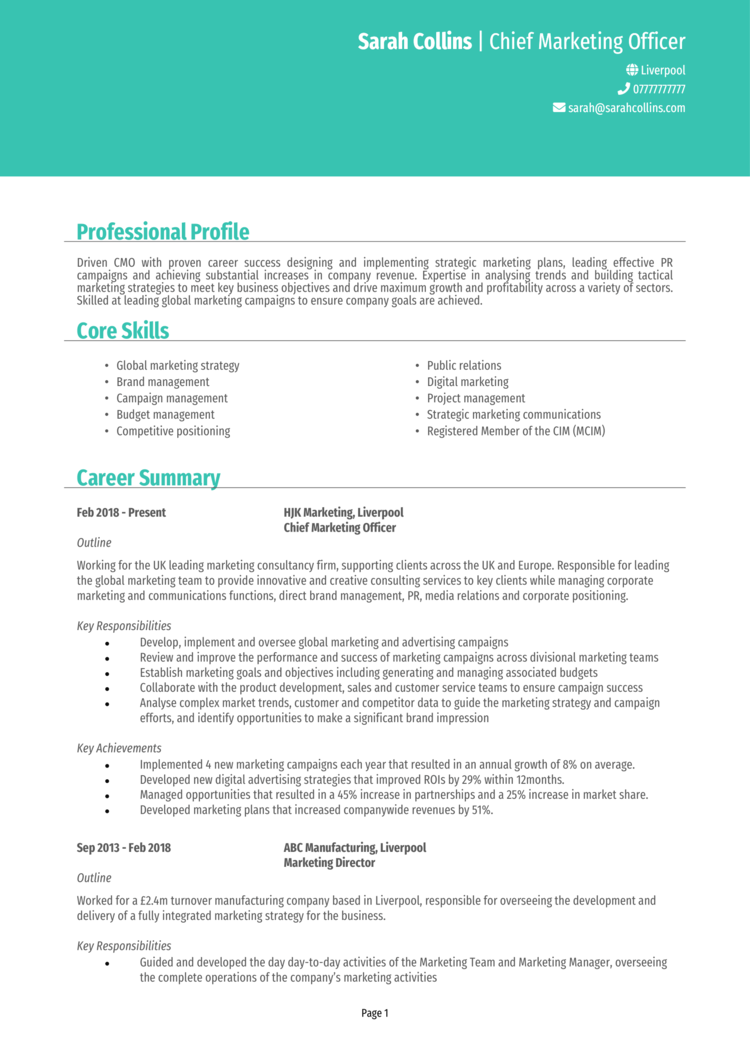
Marketing Assistant CV example

How to write your Marketing CV
Learn how to create your own interview-winning Marketing CV with this simple step-by-step guide.
Writing a CV for marketing needs to be as engaging and well-targeted as a high-performing ad campaign. If it’s vague, unstructured, or lacking key selling points, hiring managers won’t stick around long enough to be convinced.
In this guide, you’ll learn how to structure your CV effectively, highlight the right skills, and craft an application that grabs attention. Because in marketing, first impressions matter – and your CV is your personal brand’s first pitch.
Marketing CV structure


Marketing professionals know that presentation is everything. If your CV layout looks cluttered and unfocused, recruiters may assume your campaigns do too – let’s keep it as polished as a well-executed brand refresh.
Your CV should follow a clear structure so recruiters can quickly find what they’re looking for. Here’s the layout to follow:
- Name and contact details – Keep your personal details, along with an optional photo, at the top so employers can reach you easily.
- Profile – A strong summary that highlights your marketing expertise, key achievements, and creative strengths.
- Core skills – Provide a snapshot of your most relevant abilities, from campaign management to data analytics.
- Work experience – Detail your previous marketing roles in reverse chronological order, focusing on the impact you made.
- Education – Go through your academic qualifications like degrees and training courses, starting with the most recent.
- Additional info – This optional section includes anything from relevant awards to hobbies and interests.
Marketing CV format


A poorly formatted CV won’t just fail to impress – it might make recruiters question your attention to detail. Like any well-designed landing page, avoid the unnecessary fluff and walls of text. Your format should be as sleek and well-structured as a brand’s marketing strategy.
Follow these format principles:
- Bullet points – Break down your key information into skimmable bullet points for quick comprehension.
- Divide sections –Ensure each part of your CV is clearly defined with headings and consistent formatting.
- Use a clear and readable font – Opt for a clean, clear font to make your CV polished and easy to read.
- No more than 2 pages – Two pages is the ideal length to provide all the essential information while staying concise.
What is a Marketing CV profile?


If your CV doesn’t grab attention, you might find yourself with a lower click-through rate than an unskippable YouTube ad. Your CV profile needs to capture recruiters’ attention and convince them to dig deeper: it should capture your expertise and unique strengths as a marketer.
Marketing CV profile examples
Profile 1
Creative Marketing Executive with four years of experience in digital marketing, content strategy, and social media management. Skilled in SEO, paid advertising, and email marketing to drive brand engagement and customer acquisition. Proficient in Google Analytics, Meta Ads, and HubSpot. Passionate about crafting compelling campaigns that enhance brand visibility and deliver measurable results.
Profile 2
Results-driven Marketing Specialist with three years of experience in brand strategy, campaign execution, and market research. Adept at developing data-driven marketing plans, coordinating product launches, and optimising advertising efforts. Proficient in CRM tools, PPC management, and A/B testing to maximise campaign effectiveness. Focused on delivering innovative marketing solutions that drive business growth.
Profile 3
Experienced Marketing Manager with over six years of expertise in B2B and B2C marketing, specialising in content marketing, lead generation, and customer engagement. Skilled in developing multi-channel campaigns, managing marketing budgets, and leveraging analytics to refine strategies. Proficient in tools like Google Ads, SEMrush, and Mailchimp. Dedicated to increasing brand awareness and customer retention through strategic marketing initiatives.
What to include in your Marketing CV profile
Here’s some tips on what to make sure to highlight:
- Your marketing expertise – Whether you specialise in digital marketing, branding, or performance marketing, make it clear.
- Key skills and strengths – Highlight your best assets, from strategic thinking to content creation.
- Notable achievements – Have you increased engagement, boosted conversions, or launched a successful campaign? Show it off.
- Industry experience – Have you worked in B2B, B2C, SaaS, or agency settings? Tailor this to the role.
- Data-driven success – If you’ve improved ROI, led market research, or optimised conversion rates, mention it here.
Core skills section


A CV skills section gives employers a quick overview of your expertise. Think of it as your keyword strategy – recruiters skim for relevant skills just like Google scans for SEO terms. Marketing roles vary widely, so tailor this section to match the job description and highlight the most relevant skills.
If you’re applying for a social media role, highlight content strategy and platform analytics. If it’s a performance marketing job, focus on paid ads and data-driven optimisation.
Key skills that make a Marketing CV stand out
- Market Research and Analysis – Identifying consumer trends, competitor strategies, and industry insights to inform marketing decisions.
- Brand Management – Developing and maintaining a strong, consistent brand identity across all marketing channels.
- Content Marketing – Creating compelling content, including blogs, videos, and social media posts, to engage and attract audiences.
- Digital Marketing Strategy – Implementing SEO, PPC, email marketing, and social media campaigns to drive online visibility and sales.
- Social Media Management – Planning, scheduling, and analysing content across platforms like Instagram, LinkedIn, and Facebook.
- Campaign Development and Execution – Designing and launching marketing campaigns to generate leads, increase awareness, and drive conversions.
- Data-Driven Decision Making – Using analytics tools like Google Analytics and social media insights to track performance and refine strategies.
- Public Relations and Communications – Managing media relations, press releases, and brand storytelling to enhance reputation.
- Email Marketing – Creating and optimising email campaigns to nurture leads and retain customers.
- Marketing Automation and CRM – Utilising platforms like HubSpot or Salesforce to streamline marketing efforts and track customer interactions.
Outlining your work experience


Your work experience should do more than list job titles – it should prove your ability to create, execute, and measure successful marketing campaigns. Hiring managers want to see how you’ve delivered results and driven brand growth in practical settings.
List your roles in reverse chronological order, focusing on the impact you’ve made in each position. If you’ve worked with well-known brands, led major campaigns, or managed budgets, highlight those achievements.
Structuring your jobs

- Outline – Introduce the company, your role, and the type of marketing work you were responsible for.
- Responsibilities – Describe your key duties, such as campaign execution, content marketing, or customer engagement. Use action verbs like “developed”, “launched”, and “optimised”.
- Achievements – If you increased website traffic, boosted engagement rates, or drove record-breaking conversions, make sure to highlight it. Numbers speak louder than buzzwords.
Work experience samples for Marketing roles
Marketing Executive | BrightWave Publishing
Outline
Developed and executed digital marketing campaigns within a digital marketing agency, enhancing brand awareness and driving customer engagement for clients across various industries.
Responsibilities
- Created and managed content for social media, blogs, and email newsletters.
- Optimised website content using SEO strategies to improve search rankings.
- Monitored campaign performance using Google Analytics and adjusted strategies accordingly.
- Collaborated with graphic designers to develop eye-catching marketing materials.
- Conducted market research to identify trends and competitor activities.
Achievements
- Increased website traffic by 40 percent through improved SEO and content marketing.
- Boosted social media engagement by 30 percent with targeted content strategies.
- Generated 20 percent more leads through successful email marketing campaigns.
Marketing Coordinator | NextGen Retail
Outline
Assisted in the planning and execution of marketing campaigns within a national retail brand, focusing on promotional activities, seasonal campaigns, and customer engagement strategies.
Responsibilities
- Coordinated promotional events and product launches to drive in-store and online traffic.
- Managed social media accounts, responding to customer inquiries and promoting new collections.
- Developed email marketing campaigns to inform and engage subscribers.
- Tracked campaign performance and compiled reports for senior management.
- Worked with external agencies to design advertisements and promotional materials.
Achievements
- Increased sales by 25 percent through successful event marketing campaigns.
- Grew email subscriber list by 15 percent with targeted outreach initiatives.
- Recognised for developing innovative marketing strategies that improved brand visibility.
Marketing Manager | TechSphere Solutions
Outline
Led the marketing team within a technology company, developing and implementing strategic campaigns to drive brand awareness, customer acquisition, and market expansion in the competitive tech sector.
Responsibilities
- Developed and executed multi-channel marketing campaigns, including digital, print, and social media.
- Managed a marketing budget, optimising spend across advertising and promotional activities.
- Oversaw website and landing page optimisation to improve lead generation.
- Analysed market trends and customer behaviour to refine marketing strategies.
- Collaborated with the sales team to align marketing efforts with business goals.
Achievements
- Increased lead conversion rates by 35 percent through improved content marketing strategies.
- Reduced marketing costs by 20 percent by optimising campaign spend and targeting.
- Successfully launched a new product campaign that generated £500k in revenue.
Education section


Marketing is an industry where skills and experience often outshine formal education – but listing your qualifications still helps, just like a well-placed testimonial on a landing page. If you have a degree in Marketing, Business, or Communications, list it here.
If you’ve completed additional training in digital marketing, analytics, or SEO, make sure to highlight it. List them all in reverse chronological order, starting with your most recent.
Best qualifications for Marketing
- BA/BSc in Marketing, Business, or Communications – A solid academic foundation for marketing professionals.
- CIM (Chartered Institute of Marketing) Qualification – Highly regarded for strategic marketing roles.
- Google Analytics Certification – Essential for digital marketers focused on data-driven decision-making.
- HubSpot Content Marketing Certification – A great addition for content and inbound marketing roles.
- Meta (Facebook) or Google Ads Certification – A must-have for PPC and paid social specialists.



